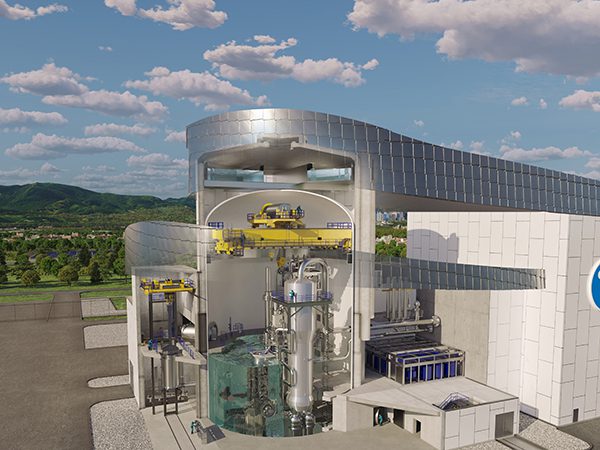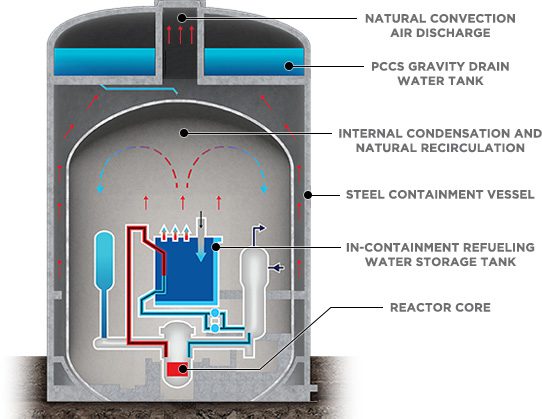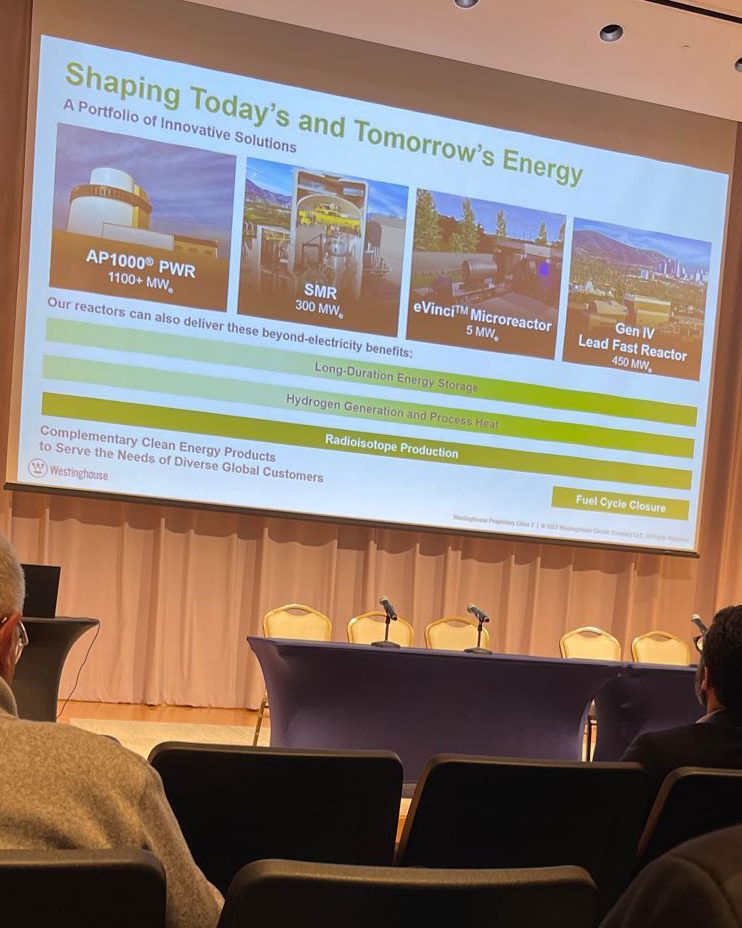Westinghouse Unveils the AP300—A Miniaturized AP1000 Small Modular Nuclear Reactor
Credit to Author: Sonal Patel| Date: Thu, 04 May 2023 17:31:07 +0000

Westinghouse has officially unveiled the AP300, a “downsized” version of the company’s flagship AP1000 Generation III+ pressurized water reactor (PWR) technology. While the small modular reactor (SMR) will enter a nuclear market already rife with development, the AP300’s “nth-of-a-kind” basis positions it as a strong competitor, the company told POWER.
The 300-MWe/900-MWth AP300, launched on May 4, is a compact single-loop version of Westinghouse’s 1,100-MWe AP1000 reactor. “We’re talking about the same technology, the same equipment, the same safety basis—there’s no new technology here,” David Durham, president of Westinghouse Electric Co. Energy Systems, told POWER in an exclusive interview.

What makes the new offering distinctive, however, is a technology with a miniature footprint that leverages decades of established development and operating experience, Durham said. “Most people don’t realize that the AP1000’s nuclear island is already considerably smaller than some SMRs that are currently being developed and marketed by competitors,” he noted. Compared to the AP1000, which was designed around a conventional two-loop, two-steam generator primary system configuration, the AP300 features a single loop.
“It’s the same passive systems, but a single steam generator instead of two,” said Durham. “So think of everything that goes along with an extra steam generator after coolant pump, piping, and everything else—we’ve eliminated all of that.” In addition, Westinghouse has moved the spent fuel storage outside the containment, he said. The AP300 will have a footprint “of less than 25% the size” of an international soccer pitch, he noted.
Like the AP1000, the AP300 integrates advanced instrumentation and controls. The SMR, however, will also leverage advancements in nuclear fuel technology. It will use Westinghouse’s Advanced Doped Pellet Technology (ADOPT)—accident-tolerant fuel technology (enriched below 5%) that is designed to improve fuel cycle economics and enhance the accident tolerance of conventional uranium dioxide (UO2) fuel pellets. The AP300 will require 121 assemblies in a 17 x 17 configuration with a four-year refueling cycle, the company said.
Westinghouse CEO Patrick Fragman during a press conference on Thursday said the company is targeting an overnight cost of $3,400/kW. That “means a plant which is expected to have a capital cost, overnight, of less than a billion dollars,” he said.

A Mid-Sized Reactor to Complete Westinghouse’s Portfolio
While the official launch of the AP300 is significant, Durham noted it stems from nearly four decades of development.
Westinghouse first embarked on developing its advanced passive (AP) technology with a 600-MWe iteration (AP600) in 1985 in an effort that responded to utility demand for certainty related to construction schedules, licensing, and operation and maintenance costs. Technology development flourished under a 1989-initiated design certification program to develop and commercialize advanced light water reactors (ALWRs) spearheaded by the U.S. Department of Energy (DOE) and the Electric Power Research Institute. Supported by thorough testing, the Nuclear Regulatory Commission (NRC) certified the AP600 standard plant design in 1999.
But in the 2000s, market conditions for larger baseload generation began to thrive again. Riding on renewed optimism for nuclear power—amid the so-called “nuclear renaissance”—Westinghouse developed the larger 1,100-MW AP1000 and launched a formal NRC licensing review in 2002. In December 2011, following a series of amendments, the NRC voted to publish a final certification rule for the AP1000 reactor design.
By 2018, four AP1000 units were operational in China: Sanmen 1 and 2 in Zhejiang province and Haiyang 1 and 2 in Shandong province, and at least six others were under construction or readying for construction. In the U.S., while two AP1000 reactors planned at V.C. Summer, South Carolina, were scrapped, construction is nearing completion at Vogtle 3 and 4 in Georgia. According to Durham, Westinghouse AP1000 technology also has been selected for nine units in Ukraine and is under consideration at multiple sites in other countries in Central and Eastern Europe, and the UK.
The AP300, notably, isn’t Westinghouse’s first SMR offering. In 2011, encouraged by the prospect of federal funding, the company rolled out a 225-MWe integral SMR design modeled on the AP1000 that eliminated large-loop piping. However, the DOE chose to invest federal funds in NuScale Power over Westinghouse and other contenders. In January 2014, after failing to find customers and admitting it could not justify the economics of its SMR without government subsidies, the company announced it would scale back its SMR program in the U.S.

300-MW: A ‘Sweet Spot’
The rollout of the new AP300 appears to be staked on Westinghouse’s development of an innovative and more comprehensive portfolio that will serve “the needs of diverse global customers” now and in the future.
When the company first unveiled the new SMR concept at the ASME Conference for Advanced Reactor Deployment in College Station, Texas, in February, Westinghouse Chief Technology Officer Rita Baranwal noted it was part of Westinghouse’s innovative vision, which for 135 years has been shaped by its customers. However, while Westinghouse technology forms the basis of 50% of the world’s operating reactors today, “one size may not fit all,” she said, noting Westinghouse’s utility customers are all exploring “additional uses for their nuclear assets.”
Baranwal suggested the SMR’s development is well-suited to decarbonizing the manufacturing sector and helping bolster the decarbonization of other industries. The AP300’s development continues alongside the eVinci, a 5-MWe portable microreactor concept that Westinghouse is readying for the market by 2027 and is “ideal for decentralization” or resiliency applications.
Westinghouse is in tandem spearheading development of a 450-MWe lead fast reactor (LFR) alongside Ansaldo Energia, she noted. The Generation IV concept’s high heat capabilities could generate process heat for myriad applications, including hydrogen generation, and it is ideally suited to enable long-duration energy storage, she said.

Quick Deployment Envisioned
Durham told POWER in April a key motivator for Westinghouse’s AP300 launch is to capture growing end users, particularly outside the U.S. “More countries are committing to decarbonization, but not all of those countries’ grids can handle large reactors,” he said. This “is very relevant in Europe and parts of Asia. Many countries use coal plants for district heating—they don’t need 1,200 MW, their sweet spot is 300 MW to 400 MW,” he said. “With the increasing decarbonization efforts, it just seemed to make sense.”
Acknowledging the urgency to act on decarbonization, Westinghouse is currently targeting a first-unit AP300 deployment within the next decade. “Much of the design is already done because it’s done for the AP1000,” Durham noted. “We’re gearing for this plant to be certified by the NRC by the end of 2027 and ready for deployment right after that,” he said. Nominally, that could be as early as “2030 to early 2030s availability for the first unit,” he said.
A more challenging task for Westinghouse, however, may entail carving a foothold in an already competitive SMR market. A direct competitor for the 300-MW market is GE Hitachi Nuclear Energy (GEH), which has already bagged its first customer—Ontario Power Generation (OPG)—for its BWRX-300, a boiling water reactor SMR. OPG plans to deploy the single-reactor at Darlington Nuclear Station by 2028. GEH is fielding several other prospects in Saskatchewan, New Brunswick, and Alberta. Other near-term potential deployments include projects in Tennessee and Poland. In March, notably, public utility giants OPG, Tennessee Valley Authority, and Synthos Green Energy formed an industry collaboration to shape a standard design for the BWRX-300. The effort seeks to speed up the technology’s regulatory acceptance and spur future deployments.
Durham, however, appears confident that Westinghouse has leverage. “If you look at the schedules that are being put out there, they match with the AP300,” he said. “And that’s the benefit of using a technology that’s already licensed by the NRC and three other countries,” he said.
Durham noted Westinghouse is already in discussions with the NRC for potential certification through Part 52. So far, it has submitted “white papers on various issues,” to resolve issues before submitting a design certification application—similar to a process it is following for its eVinci microreactor. “We anticipate a very simplified licensing process because if it’s already been approved once, we don’t think it’ll take too long to get it approved a second time,” he said.
Still, Westinghouse has yet to bag a customer. Durham confirmed the company has initiated “discussions with customers,” and he remains optimistic. “We’re not creating a supply chain for the first time,” he noted. “That’s not a criticism of our competitors—but they’ve never done it before. They’re creating suppliers at the same time they’re getting licensed for the first time. At the same time, they’re completing the design. We have all of that in place.”

Building Confidence in Costs and Construction
For Westinghouse, cultivating certainty is an important attribute given that a much-cited factor that directly affects the cost of capital, and, ultimately, a nuclear project’s levelized cost of electricity (LCOE)—is the risk of delays. The AP1000 expansion at Vogtle, prominently, is frequently referenced as an example of exorbitant delays and cost overruns. That hasn’t been the case at all AP1000 projects, however. The economics of building an AP1000 are pegged to several factors and may vary wildly by region, as a recent economic study from the Massachusetts Institute of Technology suggests.
Still, Westinghouse has paid keen attention to past debacles, Durham said. Armed with lessons from its projects in China and the U.S., the company has incorporated optimizations in the design of the AP300, he noted. For now, Westinghouse envisions that an AP300 plant could take three years to build.
“It’s always more difficult the first time you do anything and that’s true for anything,” Durham noted. However, “it’s important to keep doing it, because as the U.S. learned with Vogtle, if your country doesn’t build a reactor for 30 or 40 years, then you’re kind of relearning it all over again.” With its global AP1000 projects, Westinghouse has effectively conformed to “serial construction,” and that has been “directly relevant to the AP300,” he said.
For example, Westinghouse will pursue a standard design for the AP300 as it has with the AP1000, Durham said. “It’ll be one standard design offered around the world. It’ll be important for any SMR developer to follow that same process and not make the same mistakes that were made in the 1970s and 1980s,” he said.
Another lesson stemming directly from the Vogtle project is “don’t start construction until you have 100% completed design. Different people will have a different definition of what a completed design means,” Durham said. “I think it’s important that you have a very conservative view of what 100% completed design means before you start construction, because, in the end, then you will eliminate a substantial amount of the risk of construction cost overruns or schedule overruns.”
Ultimately, “there’s never a guarantee, but it is absolute reassurance that you don’t start construction until the design is complete, you don’t change the design, you don’t change the suppliers, you don’t change the technology. That gives the customer a great deal of confidence regarding the cost and schedule of what’s to come,” he said.
Economic Feasibility in Transitioning Markets
Keeping capital costs manageable also directly plays into how the AP300 will sustain competition with other energy resources. “We validated this with some customers,” Durham noted. “An SMR—just because it’s smaller, and particularly with the footprint like the AP300—will cost less in total dollars,” he said. “We’re talking single, low-billion versus double-digit billions for a big project.” However, “we know and our customers know the LCOE of an SMR will not be as good as a 1,200-MW plant. It’s just economies of scale,” he explained.
“The key is to make sure that it is as low cost as possible, and we’re convinced that we’ve hit that sweet spot with the AP300 … because it’s so small, it’s so much easier to operate, and so much less costly to operate and maintain.” That 300-MW “sweet spot,” for example, allows the AP300 to be well-suited to smaller brownfield sites, like retiring coal plants, he suggested.
Durham cautioned against cost comparisons given discrepancies. However, he did not downplay the technology’s potentially high costs. “There are a lot of claims being made in the industry regarding costs, and unfortunately, I think they’re doing a disservice to the whole industry,” he said.
“This isn’t going to be too cheap to meter or [equivalent to] the cost of a gas plant,” he said. AP300s “are going to cost more, but the benefit is you’re going to have low-cost production, low-cost energy for the life of the plant—the 60 or 100 years it’s going to operate—and it’s going to be very predictable.” For one, “you don’t have the fluctuations that you have in gas, and obviously you don’t have the carbon impacts that you have with gas or coal,” he said.
Westinghouse is also clear-eyed about markets in which customers are better positioned to justify the cost of new nuclear, Durham noted. While the U.S. still has to reach a country-wide commitment to decarbonization, state-owned utilities in many countries, particularly in Europe, offer good prospects for new nuclear. “The U.S. will be kind of a little bit spotty,” Durham predicted.
“I think there are areas that you’ll see new nuclear new build achieved, but you’ll see other areas, where for whatever reason, maybe it’s because it’s a non-regulated market, where it’s tougher to make that kind of 50-year commitment and to look at those kinds of terms, it’ll be tougher to justify the cost of new nuclear.”
—Sonal Patel is a POWER senior associate editor (@sonalcpatel, @POWERmagazine).
The post Westinghouse Unveils the AP300—A Miniaturized AP1000 Small Modular Nuclear Reactor appeared first on POWER Magazine.